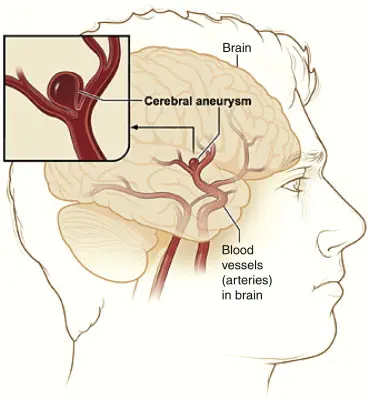Brain Aneurysm
Introduction to Brain Aneurysm
A brain aneurysm, also called a cerebral aneurysm or intracranial aneurysm, is a weak, bulging area in the wall of a brain artery. Over time, the pressure of blood flow can cause this weakened vessel wall to balloon outward, forming a sac-like dilation. Brain aneurysms can occur anywhere in the cerebral circulation, but are most often found at branching points of the Circle of Willis in the base of the brain. If an aneurysm ruptures, it can lead to subarachnoid hemorrhage (SAH), a life-threatening type of stroke that requires immediate neurosurgical intervention.
Brain Anatomy and Aneurysm Formation
The brain receives blood supply from the internal carotid arteries and vertebral arteries, which branch into smaller vessels forming the Circle of Willis. Aneurysm formation is often linked to structural weakness in the tunica media (middle layer) of the vessel wall, combined with hemodynamic stress at arterial bifurcations. Common locations include:
- Anterior communicating artery (AComA)
- Posterior communicating artery (PComA)
- Middle cerebral artery (MCA) bifurcation
- Basilar artery tip
Types of Brain Aneurysms
- Saccular aneurysm (berry aneurysm) looks like a round sac on a vessel.
- Fusiform aneurysm Involves circumferential widening of the artery.
- Dissecting aneurysm Caused by a tear in the inner vessel wall, allowing blood to enter and split the layers.
Causes
Brain aneurysm formation is influenced by a combination of genetic, structural, and environmental factors.
Some examples of causes :
-
Hypertension (high blood pressure)
- Family history of aneurysms or genetic disorders (Ehlers-Danlos syndrome, Marfan syndrome)
- Head trauma
- Atherosclerosis
-
Age (most common in adults over 40)
- Infections affecting blood vessels (mycotic aneurysms)
Symptoms of Brain Aneurysm
Many unruptured brain aneurysms cause no symptoms and are discovered incidentally during MRI or CT scans for other conditions.
Possible symptoms of an unruptured aneurysm:
- Localized headache
- Eye pain or vision changes
- Dilated pupil
- Numbness or weakness on one side of the face
- Difficulty speaking or concentrating
Symptoms of a ruptured brain aneurysm:
- Sudden, severe headache (“thunderclap headache”)
- Nausea and vomiting
- Stiff neck
- Sensitivity to light (photophobia)
- Seizures
- Loss of consciousness
- Neurological deficits (hemiplegia, aphasia)
Diagnosis of Brain Aneurysm
Medical imaging is crucial for detection and characterization of aneurysms:
- Computed Tomography (CT) scan Fast initial test for suspected rupture
- CT angiography (CTA) Detailed blood vessel imaging
- Magnetic Resonance Imaging (MRI) Brain tissue and vessel structure
- Magnetic Resonance Angiography (MRA) Non-invasive vessel visualization
- Cerebral digital subtraction angiography (DSA) Gold standard for detailed mapping before surgery
- Lumbar puncture Detects blood in cerebrospinal fluid if CT is inconclusive
Biotechnology and Medical Innovations
Modern biotechnology is revolutionizing brain aneurysm diagnosis and treatment:
- 3D rotational angiography for surgical planning
- Biodegradable coils that promote vessel healing
- Artificial intelligence (AI) powered aneurysm detection in MRI/CTA scans
- Genetic testing for inherited vascular disorders
- Robotic-assisted neurosurgery for precision clipping
